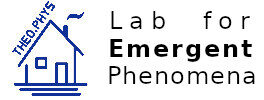Master thesis – Ludwig Peschik
Ludwig Peschik
Towards a Gauge Theory in Finite Projective Physics [PDF]
finished 2021-11
supervised by Klaus Mecke
Abstract
One of the most challenging issues of contemporary theoretical physics is the unificationof Einstein’s General Relativity with Quantum Field Theory, most notably known as theconceptual framework of the Standard Model of Particle Physics. In this new attempt of Finite Projective Physics, an event-based ontology is employed where sequences of events are the main point of interest. This leads to an embedding into a projective space 𝔽qPn over a finite field 𝔽q equipped with a (bi-)quadric field such that predecessors andsuccessors of an event are elements of the quadric at the event and lie on a straightline through the centre of this quadric by the law of inertia. Relativistic Newtonian mechanics can be described naturally by an additional translation of a flat and force-free quadric field in the physical affine subspace proportional to the force acting on the body. In this thesis, we at first review and explain necessary mathematical concepts like finite fields and projective spaces and add additional explanatory theorems which may not be found in text books on these topics. Furthermore, we provide an overview over the description of relativistic Newtonian mechanics in the framework of Finite Projective Physics and explicitly construct the trajectory of a massive body under the influence of an arbitrary force field. Using the Lorentz force of a constant electromagnetic field, we show that the relativistic motion of a massive and charged body in this electromagneticfield in dimension n=4 can be recovered using this new ansatz, but deviations from the analytical solution arise in the ultra relativistic regime on longer time scales. We show that the use of non-constant electromagnetic fields in our description leads in particular to the requirement of a constant magnitude of the electric field and a constant Poynting vector along the trajectory. In the next chapter, we describe various ideas of a geometrical implementation of gauge theories using in particular symmetry groups of the intersection of two quadrics and thereof derived geometrical structures like the hyper-plane of intersection, and show that in two dimensions in the case of quadrics translated with respect to each other with respect to some hyperplane at infinity the symmetry group of the intersection is isomorphic to the symmetric group S4 on the four elements of intersection. In higher dimensions, we show that not every permutation of points of this intersection is possible. Afterwards, we describe an idea of how to implement charges by means of matrices which are invariant under conjugacy with certain trans-formations. Lastly, we discuss how an introduction of gravity could help to eliminate the problems which arise in the case of non-constant electromagnetic fields, and explainpossible benefits of changing the theory from a theory of translations to a theory of lines.
One of the most challenging issues of contemporary theoretical physics is the unificationof Einstein’s General Relativity with Quantum Field Theory, most notably known as theconceptual framework of the Standard Model of Particle Physics. In this new attempt of Finite Projective Physics, an event-based ontology is employed where sequences of events are the main point of interest. This leads to an embedding into a projective space 𝔽qPn over a finite field 𝔽q equipped with a (bi-)quadric field such that predecessors andsuccessors of an event are elements of the quadric at the event and lie on a straightline through the centre of this quadric by the law of inertia. Relativistic Newtonian mechanics can be described naturally by an additional translation of a flat and force-free quadric field in the physical affine subspace proportional to the force acting on the body. In this thesis, we at first review and explain necessary mathematical concepts like finite fields and projective spaces and add additional explanatory theorems which may not be found in text books on these topics. Furthermore, we provide an overview over the description of relativistic Newtonian mechanics in the framework of Finite Projective Physics and explicitly construct the trajectory of a massive body under the influence of an arbitrary force field. Using the Lorentz force of a constant electromagnetic field, we show that the relativistic motion of a massive and charged body in this electromagneticfield in dimension n=4 can be recovered using this new ansatz, but deviations from the analytical solution arise in the ultra relativistic regime on longer time scales. We show that the use of non-constant electromagnetic fields in our description leads in particular to the requirement of a constant magnitude of the electric field and a constant Poynting vector along the trajectory. In the next chapter, we describe various ideas of a geometrical implementation of gauge theories using in particular symmetry groups of the intersection of two quadrics and thereof derived geometrical structures like the hyper-plane of intersection, and show that in two dimensions in the case of quadrics translated with respect to each other with respect to some hyperplane at infinity the symmetry group of the intersection is isomorphic to the symmetric group S4 on the four elements of intersection. In higher dimensions, we show that not every permutation of points of this intersection is possible. Afterwards, we describe an idea of how to implement charges by means of matrices which are invariant under conjugacy with certain trans-formations. Lastly, we discuss how an introduction of gravity could help to eliminate the problems which arise in the case of non-constant electromagnetic fields, and explainpossible benefits of changing the theory from a theory of translations to a theory of lines.
